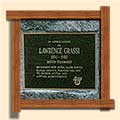 Heritage Community Foundation Presents
Heritage Community Foundation PresentsAlberta Online Encyclopedia
 |
||
  |
||
|
Home>> People and Communities>> People/Miner Profiles>> Banff and Canmore>> Lawrence Grassi |
||
| Lawrence Grassi | ||
|
Carolynn Van de Vyvere
"He was a true mountain man," said Bill Cherak, whose father sold Grassi the cabin where he lived until just before he died in 1980. Cherak, who was also Grassi's friend and the executor of his estate, said Grassi left the cabin much as he'd found it more than 50 years before—with no plumbing or hot water and just a coal-burning stove for heat. "This modern society wasn't for him," said Cherak. "He lived for the mountains" The personal history of this industrious man reflects the history of the industries that built Banff and Canmore. After immigrating to Canada in 1912, Grassi worked for the Canadian Pacific Railway. He then became a coal miner, a mountain guide, and finally a park warden at Lake O'Hara. A seasoned mountaineer, Grassi completed several significant first ascents—including a first solo climb of Mt Assiniboine—with little fanfare, and guided everyone from politicians to the Alpine Club of Canada through the Rockies. However, Grassi's trail-making has been his greatest legacy. Hikers can follow in his footsteps on the four km Grassi Lakes Trail, just a few kilometres south of Canmore off the Smith-Dorrien Spray Trail past the Nordic Centre. The trail starts about 90 metres from the parking lot along the service road. At the first fork, follow the sign for the more difficult route leading to the left. Quite challenging, the route, chosen by Grassi himself, is worth the effort. "The trail makes it possible for you to follow Grassi into the mountains, to see the views, the route, and the sights that he picked for you," says Canmore historian and Grassi biographer Bob Sandford. Building trails was a labour of love for Grassi, whose dogged work ethic and romantic sense of aesthetics are imprinted on all of his paths. His eye for beauty is clearly reflected on the Grassi Lakes route. The first kilometre is a gentle ascent on a well-defined path through woods speckled with wildflowers. This contrasts with the drama of the last section, where the trail climbs quickly over stone steps, but affords sweeping panoramas of the Bow Valley and breathtaking views of the 300 metre waterfalls under Ha Ling Peak. At the hike's summit are the Upper and Lower Grassi Lakes, called the Twin Lakes until they were renamed in Grassi's honour in 1938. The geology of the location sets off the crystal clear Grassi pools, azure blue and emerald green in colour. The lakes are situated on a petrified coral reef and are underlined by a thermal sulphur spring that feeds into the lakes via a fault line. The sulphur content of the water keeps it clear, and the intense colours of the algae and stone are created by the water's mineral content. Historians speculate that Grassi's understanding of geology from mining led to his interest in these lakes. "He understood the mountains inside and out," says Sandford, speaking literally of Grassi's experience as a mountaineer and a miner. A short scramble above the Upper Lake leads to a canyon where Grassi's history meets prehistory. Millennium-old pictographs, believed to be painted by Ktunaxa First Nation ancestors, are visible on boulders. For those who want to skip the extra scramble, the slope's base affords a good view of the climbers often navigating the porous cliffs above the lakes. "Grassi Lakes Trail is one of the nicest places for an afternoon hike because it's got everything," says Frank Gee, coordinator of interpretative guiding for Discover Banff Tours. "There's the history of Grassi, prehistory, sweeping views, and beautiful scenery." Carolynn Van de Vyvere is a freelance writer in Calgary. The article titled "Grassi Lakes and the Grassi Trail" by Carolynn Van de Vyvere is
reprinted from Legacy
Magazine Fall 2003 issue. The Heritage Community Foundation and
the Year of the Coal Miner Consortium would like to thank Carolynn Van de Vyvere and Barbara Dacks, the Publisher/Editor
of Legacy Magazine, for permission to reprint this material. |
||
 |
||
For more on coal mining in Western Canada, visit Peel’s Prairie Provinces.

